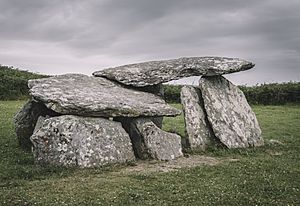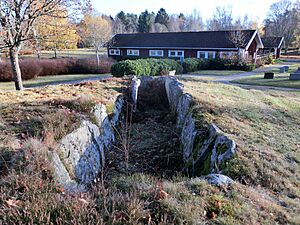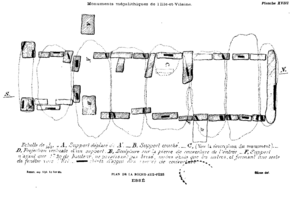Gallery grave facts for kids
A gallery grave is a very old type of tomb built from large stones. These tombs were mostly made in Europe during the Stone Age. You could walk straight into the main part, called the gallery, without going through a separate entrance room. There are several main types, like complex, transepted, segmented, and wedge-shaped. They were often covered by a mound of earth, called a "tumulus", or a pile of rocks, called a "cairn".
Contents
What are Gallery Graves?
Experts believe gallery graves were used as burial sites for a whole community. People buried there were likely from the same family or village. This helped to strengthen their feeling of being a group.
Gallery graves could be straight or shaped like an "L". Sometimes, a special burial room was at the very end of the gallery. The walls were made from large, flat stones called orthostats, set upright in the ground. The roof was made of several flat stones. If there was a special burial room, it usually had one very large stone for its roof.
People used these graves in different ways. Sometimes, many burials happened at once. Other times, the grave was opened again and again for new burials. Or, it might have stayed open for a long time to accept many people.
In some gallery graves, burials were made in the main gallery. Others had small burial rooms opening off the main gallery. These are called "complex gallery graves". If these side rooms were in pairs, it was a "transepted gallery grave". Some galleries were divided by stone slabs inside; these are "segmented gallery graves". If two parallel galleries led to one burial room, it was a "parallel gallery grave".
Some gallery graves were not rectangular. They got narrower towards the back, like a wedge. These are called wedge-shaped gallery graves. Their ceilings often sloped down towards the back. A stone sill or upright slabs near the entrance created a small front area. Wedge-shaped graves were usually covered by a cairn (stone pile). Sometimes, an earth mound was used instead. The stone pile could be round, oval, or D-shaped. A ring of stones, called a kerb, often held the cairn in place.
Some wedge-shaped graves had curved back walls, while others were straight. A few had a burial room at the very back, but it was usually blocked off. These graves often faced west. They sometimes had outer walls that were parallel to the inner ones, or angled even more to make the wedge shape stronger.
The earth mound (or "barrow") covering a gallery grave could be oval or long. Its sides might be parallel or not. The mound was built so the end of the gallery was in its center. A single mound could even cover several gallery graves that spread out from the middle. Over time, the earth on top often washed away. This is why many gallery graves today are open to the air, even though they were once deep inside a mound.
Gallery Grave vs. Passage Grave
Gallery graves are different from passage graves, even though both have smaller burial rooms off a main path.
- In a gallery grave, the main gallery is as tall and wide as the side burial rooms. In a passage grave, the passage is not as tall or wide as the burial rooms.
- Gallery graves are usually covered by a V-shaped earth mound. Passage graves are almost always covered by a round mound.
Types of Gallery Graves
Transepted Gallery Graves
Transepted gallery graves have burial monuments with side rooms. These rooms stick out sideways from a main central room. You can find them in the Loire valley in France, southwest Great Britain, and Ireland. It's thought that the people who built them had similar cultures.
Wedge-shaped Gallery Graves


A wedge-shaped gallery grave or wedge tomb is a type of Irish chamber tomb. They are called "wedge" because the burial room gets narrower at one end. This usually means it gets both shorter and less wide from west to east. A simple stone slab or sill separates a small front area from the main burial space. The entrance usually faces west.
A special feature of wedge tombs is that their main gallery has double walls. They were often covered by cairns (piles of stones). These stone piles could be round, oval, or D-shaped. They often had a kerb (stone ring) to hold them in place. Most are not very tall, usually about 1.5 meters high. You often find them on mountainsides, about three-quarters of the way up.
Wedge tombs were built between the late Neolithic (Stone Age) and middle Bronze Age in Ireland. This was roughly from 2500 to 2000 BC. Today, about 500 to 550 known wedge tombs still exist in Ireland. Most of them are found in the west and northwest parts of the island.
When Were Gallery Graves Built?
Gallery graves are one of the most common large stone tombs in western Europe. Others include the dolmen and passage grave.
Most gallery graves were built during the Neolithic Age. This period started around 10,200 BC and ended in Europe about 3,200 BC. However, some were also built later, in the Middle and Late Bronze Age, from about 2,300 BC to 600 BC. It can be hard to figure out the exact age of some gallery graves. This is because they might have been built in the late Stone Age or early Bronze Age, but then reopened and used for burials until the late Bronze Age.
Examples of Gallery Graves

Experts Ian Shaw and Robert Jameson said in 1999 that the best-studied gallery graves are the Severn-Cotswold tombs. These are found in Wales and South West England in the United Kingdom. Other important gallery graves include:
- Court cairns, found in western and northern Ireland and southwest Scotland.
- Giants' graves in Sardinia.
- Glantane East wedge-shaped tomb in Ireland.
- Naveta graves in Menorca.
- allées couverte from the Seine-Oise-Marne culture in northern France and southern Belgium.
- Stone cist group tombs from the Wartberg culture in northern Hesse, southern Lower Saxony, and western Thuringia in Germany.
See also




